Agricultural and Biological Research
RNI # 24/103/2012-R1
Research Article - (2023) Volume 39, Issue 3
Potato is a high-yielding potential crop grown for its high nutritional value but constrained with low soil fertility. The aim of this study was to assess the effect of vermin-compost and blended NPS fertilizer rates on potato yield and yield components. Four rates of NPS fertilizers (0, 150, 200, and 250 kg NPS ha-1) and four rates of vermin-compost (0, 4, 6, and 8 t ha-1) applied in 4 × 4 factorial combination in randomized complete block design with 3 replications. The result revealed significant influence of NPS fertilizers and vermin-compost on all parameters. The application of blended NPS fertilizer integrated with vermi-compost resulted superior to the application of either NPS fertilizer or vermin-compost alone. Combined application of 8 t ha-1 vermi-compost with 250 kg ha-1 blended NPS fertilizer resulted high performance for most of traits including marketable tuber yield (27.4 t ha-1) and total tuber yield (27.9 t ha-1).The finding suggests the application of 250 kg ha-1 blended NPS with 8 t ha-1 vermi-compost is profitable with a net benefits of about 2761 USD with a 315.9% marginal rate of return. Increasing levels of treatment resulted an increasing yield trend, indicating further study is required to identify the optimum rate of recommendation of both fertilizers.
Marketable yield; Interaction plot; Soil fertility management; Tuber yield
Potato (Solanum tuberosum L.) is a vital food-security crop and substitute for cereal crops considering its high yield and great nutritive value [1]. In Ethiopia, the potato crop is nutritionally rich staple foods that contribute carbohydrates, protein, vitamin C, vitamin A, zinc, iron, and minerals which alleviate the problem of malnutrition in subsistence farmers and towns [2]. The amount and availability of plant nutrients in the soil, significantly influence plant growth rate, maturity time, size of plant parts, and biochemical content of plants and seed capabilities [3]. In Ethiopian report showed that potato productivity has been limited partly due to soil fertility which plays a major role in influencing the growth and production performance of potatoes [4]. Based on the national soil database, the EthioSIS soil fertility mapping project in Ethiopia reported that there are deficiencies of K, S, Zn, B, and Cu including N and P in Ethiopian soils and hence recommended customized and balanced fertilizers [5]. Currently, there is an increasing interest in the use of organic amendments to minimize the impact of inorganic fertilization [6].
The increase in the cost of mineral fertilizers; coupled with related ecological concerns has made an integration of mineral fertilizer and vermin-compost nutrient sources as more sustainable [7]. Vermi-compost is a type of organic fertilizer produced by biodegradation of organic material through interactions between earthworms and microorganisms, contains nearly all types of nutrients necessary for plant growth, and is rich in microbial growth and activities [8]. The use of organic manure with a combination of chemical fertilizers helps in improving physic-chemical properties of the soil, improves the efficient utilization of applied fertilizers resulting in higher seed yield and quality, provide a conducive environmental condition for microorganisms and soil structural properties [9]. An integrated fertility management strategy is useful to maintain soil fertility for sustainable production of potato through careful use of fertilizers [10]. Some report showed that vermin-compost (10 t ha-1) with NPKS (100%) produced the highest growth and yield of potato [11]. Research indicate that the application of vermin-compost combined with NPS fertilizers improved organic matter and nutrient contents of soils which in turn increased crop yields [12] and vermin-compost applied at 6 t ha-1 has caused a significant improvement in the soil quality and productivity of potato [13].
In the study area of Horro-Guduru highland, the production of potato with inorganic fertilizer has been promoted for many years which have associated effects on soil fertility, soil biology and sustainability of production. However, the strategy of integrated use of vermin-compost with NPS fertilizer was not well known which would improve sustainability of potato production in the study area Therefore, the aim of this study was to examine the effect of rate of vermin-compost and blended NPS fertilizer on yield and yield components of potato and to identify economically feasible rates of blended NPS fertilizer.
Study area
The experiment was conducted at Gitilo Dale site, Horo-Guduru Wollega Zone, Western, Ethiopia during 2019 cropping season under rain fed condition. The experimental site is located at 09032'299''N-037003'911''E and at an altitude of 2795 meters above sea level (masl) and receives an annual rainfall of 1650-1780 mm, especially in July and August being the peak rainy months. The average temperature of the area is 22˚C and the pH of the area was 4.8 [14]. Wheat, barley and potato are among major crops growing in the study area.
Experimental materials
A potato variety known as ‘Gudanie’ (accession No. CIP-386423.13) was used as experimental material. This variety was released in 2006 by Holeta Agricultural Research Centre (HARC), Ethiopia and Gudane was selected based on its high yield, wider adaptation, and moderate resistance to late blight in the highlands of Horro Guduru Wollega Zone than other varieties. Blended NPS was used as a source of (19% N, 38% P2O5, and 7% S) and vermin-compost was applied. The worm Aesinia fetida was used to produce Vermicompost and the worm was introduced from Gudar Lime factory, Ethiopia.
Experimental design and treatments
The experiment was laid out in Randomized Complete Block Design (RCBD) in a 4 × 4 factorial arrangement which was replicated three times per treatment. Thus, each factor consists of four levels of vermin-compost and four levels of NPS fertilizers treatments. The levels were 0, 4, 6, and 8 t ha-1 for vermin-compost and 0, 150, 200, and 250 kg/ha blended NPS (Nitrogen, Phosphorus, and Sulfur). Totally, 16 treatment combinations (Table 1) of which treatment was applied to a plot with a gross area of 9.0 m2 (with 2.4 m length and 3.75 m width) containing five rows, with each row accommodating 8 plants with a total population of 40 plants per plot at the spacing of 0.75 m and 0.30 m between rows and plants, respectively, of which the net plot size was 2.25 m × 2.4 m=5.4 m2. The spacing between plots and adjacent blocks were 1 m and 1.5 m, respectively. The full dose of vermin-compost and NPS, as per treatment, was applied as a basal dressing at planting.
| Treatment | Description |
|---|---|
| T1 | Control (0 fertilizer) |
| T2 | 150 kg ha-1 NPS blended fertilizers |
| T3 | 200 kg ha-1 NPS blended fertilizers |
| T4 | 250 kg ha-1 NPS blended fertilizers |
| T5 | 4 t ha-1 Vermicompost |
| T6 | 4 t ha-1 Vermicompost+150 kgNPS blended fertilizers |
| T7 | 4 t ha-1 Vermicompost+200 kg ha-1NPS blended fertilizers |
| T8 | 4 t ha-1 Vermicompost+250 kg ha-1NPS blended fertilizers |
| T9 | 6 t ha-1 Vermicompost |
| T10 | 6 t ha-1 Vermicompost+150 kg ha-1NPS blended fertilizers |
| T11 | 6 t ha-1 Vermicompost+200 kg ha-1NPS blended fertilizers |
| T12 | 6 t ha-1 Vermicompost+250 kg ha-1NPS blended fertilizers |
| T13 | 8 t ha-1 Vermicompost |
| T14 | 8 t ha-1 Vermicompost+150 kg ha-1NPS blended fertilizers |
| T15 | 8 t ha-1 Vermicompost+200 kg ha-1NPS blended fertilizers |
| T16 | 8 t ha-1 Vermicompost+250 kg ha-1NPS blended fertilizers |
Table 1: Description of treatment combination
Experimental procedures
The land was prepared according to the crop requirement as recommended by Holeta Agricultural Research Center. Tubers with a medium size (25-75 g) and well-developed sprouts of each variety were planted at a spacing of 75 cm × 30 cm between rows at a depth of 15 cm. Fungicide (Ridomil MZ 65WP) was sprayed two times at the rate of 2.5 kg ha-1 at the interval of 7 days to control late blight (Phytophthora infestans) disease. Other recommended cultural practices such as weeding, cultivation, and ridging were applied to all plots during the period of the study as recommended. The following steps were followed for vermin-compost preparation:
1) The vermicomposting unit was in a cool, moist, and under corrugated iron house shady site.
2) Three days after extraction, the cow dung was mixed with water and chopped dried nontoxic leaves (such as broad leaves Cardio africana) and grasses were mixed in the proportion of 3:1 and kept for partial decomposition for 15-20 days and gets ready in 45-50 days.
3) A layer of 15-20 cm of chopped dried leaves/grasses was kept as a bedding material at the bottom of the bed.
4) Beds of partially decomposed material of size 182.88 cm*60.96 cm*60.96 cm were made.
5) Each bed was contain 1.5-2.0 q of raw material (cow dung, chopped dried broad leaves (Cardio africana), grasses and the number of beds can be increased as per raw material availability and requirement.
6) Red earthworm (1500-2000 of numbers) which is adult (3-5 month ages, length 0.8-10 cm, weight 0.5-0.6 gram) were released on the upper layer of bed and 10 earthworms are required to decompose one kilo gram of leaves.
7) Water was sprinkled using a watering cane immediately after the release of worms.
8) Beds were kept moist (60%-70% moisture content) by a sprinkling of water (daily) and by covering with polythene.
9) The bed was turned once after 30 days for maintaining aeration and for proper decomposition until the compost matured 45-50 days.
10) Matured and well-decomposed product (vermin-compost with no odor brown or brown-black color, not compacted or rolled) was used for the experiment.
Data collection
Five plants were selected randomly from central rows of each treatment for recording data on yield and yield components parameters. The plants were picked at random carefully from the middle three ridges and dug out.
Marketable tuber number per hill
This was recorded as the actual number of tubers to be collected from 5 matured plants at harvest based on their size category (more than 25 g considered marketable).
Unmarketable tuber number per hill: the number of tubers that are diseased and/or rotting ones and small-sized (less than 25 g in weight) were recorded.
Total tuber number per hill
This was counted as the sum of marketable and unmarketable tuber numbers from the net plot
Tuber dry matter yield
Healthy tubers taken from randomly selected five plants per harvestable plot were washed, chopped, and dried in an oven with a forced air circulation at 105˚C for about 24 hours for determination of tuber dry matter yield.
Above-ground dry biomass (g hill-1)
This was recorded as dry weight of leaves, branches, and stems (g) and determined from 5 randomly taken plants at physiological maturity.
Marketable tuber yield (t ha-1)
The weight of tubers which are free from diseases, insect pests, and greater than or equal to 25 g in weight were recorded from 5 randomly taken plants per plot and calculated based on t ha-1.
Unmarketable tuber yield (t ha-1)
The weight of tubers that are diseased and/or rotting ones and small-sized (less than 25 g in weight) were recorded and calculated based on t/ha.
Total tuber yield (t ha-1)
The total tuber yield was obtained by adding marketable and unmarketable tuber yields and calculated based o t ha-1.
Tuber size category (g hill-1)
The weight of tubers which were medium (25-75 g), large (>75 g) grades (size), and small (<25 g) tubers were obtained from 5 randomly taken plants per hill. Further, soil-related data obtained through laboratory analysis were considered.
Partial budget analysis
The economic analysis was carried out using the methodology described in CIMMYT [15] in which prevailing market prices for inputs at planting and outputs at harvesting were used. All costs and benefits were calculated on ha basis in USD. The concepts used in the partial budget analysis were the mean marketable tuber yield of each treatment, the Gross Benefit (GB) ha-1 (the mean marketable tuber yield for each treatment), and the field price of fertilizers (the costs of blended NPS and the application costs).
Dominance analysis (identification and elimination of inferior treatments)
This was also used to eliminate those treatments which involve higher costs but do not generate higher benefits. Dominated treatment (marked as "D"). Identification of a candidate recommendation was from among the non-dominated treatments. That is the treatment that gives the highest net benefit and a marginal rate of return greater than the minimum considered acceptable to farmers (>1 or 100%).
Data analysis
Crop data had been subjected to analysis of variance, the usage of R statistical software (R i386 3.2.3 version) [16]. The Least Significant Difference (LSD) was applied to separate the extent of difference between means at 5% probability level. A graphical illustration of the main and interaction effects of both factors was given in the form of box and interaction plots using boxplot and interaction plot function of R as box plot and interaction plot helps compare the trend of the interaction and distribution of data across data sets.
Yield and yield components performances in potato
Analysis of variance: The statistical analysis of variance revealed that the main effects and interaction effects of different rates of NPS fertilizer and Vermi-Compost (VC) rates had significant (p<0.01) effect on marketable tuber numbers per hill, number of total tubers, marketable tuber yield, unmarketable tuber yield, total tuber yield, tuber dry weight yield, above ground biomass, large-sized tuber, medium tuber size and small tuber size (Table 2).
| Source of variation | DF | Mean square | ||||||||||
|---|---|---|---|---|---|---|---|---|---|---|---|---|
| Tuber number | Tuber Yield (t/ha) | BM | TDM | Tuber category (g/hill) | ||||||||
| Mark. | Unmark | Total | Mark. | Unmark | Total | Small <25 g) | Medium | Large(>75 g) | ||||
| (25-75 g) | ||||||||||||
| Rep | 2 | 0.04 | 6.4 | 0.5 | 0.03 | 0.6 | 14.153 | 183.1 | 39.7 | |||
| VC | 3 | 55.8** | 1.3** | 41.4* | 244.1** | 0.98** | 217.8** | 949.9** | 8456.2** | 546.441** | 13979.6** | 72574.3** |
| NPS | 3 | 39.9** | 0.3** | 31.3** | 147.3** | 0.07** | 141.4** | 155.3** | 5376.8** | 40.154** | 16423.8** | 28288.0** |
| VC*NPS | 9 | 1.6** | 0.01ns | 1.5** | 14.1** | 0.08** | 13.4** | 40.8* | 561.3** | 43.687** | 3929.2** | 12061.0** |
| Error | 30 | 0.3 | 0.04 | 0.3 | 1.2 | 0.01 | 1.2 | 14.5 | 30.6 | 5.576 | 481 | 48.2 |
| Total | 47 | 97.7 | 8.1 | 74.5 | 407.1 | 1.17 | 374.4 | 1188 | 14432.2 | |||
| CV% | 7.7 | 12.2 | 5.8 | 6.62 | 10.99 | 6.46 | 11.6 | 5.3 | 11.01 | 10.4 | 3.97 | |
Note: DF: Degree of Freedom, Rep: Replication, *significant at (P=0.05), **significant at (P=0.01), Mark: marketable, Unmark: unmarketable, BM: Biomass yield/plant (g), TDM: Tuber Dry Matter yield/plant, VC: Vermicompost, NPS: Nitrogen Phosphorus Sulfur.
Table 2: The mean square values of ANOVA for yield and yield components of potato under vermicompost and NPS fertilizer application at Gitilo (2019).
Marketable and unmarketable tuber number/plant
Though the various levels of both factors combinations tend to increase the marketable yield, but the application of 8 t ha-1 vermicompost integrated with 250 kg/ha NPS had recorded maximum marketable tuber number per hill (12.3) (Figure 1) while an increased levels of both vermicompost and NPS fertilizers significantly reduced the unmarketable tuber number per plant being at 8 t ha-1 vermicomposts the marketability of tuber was very higher (Figure 2). Overall the use of 8 t ha-1 vermicompost combined with 250 kg/ha NPS fertilizer had recorded the maximum marketable total tuber number/plant (13.5 t ha-1) whereas the lowest (5.9 5 t ha-1) was recorded from unfertilized plot (5.9) (Figure 3).
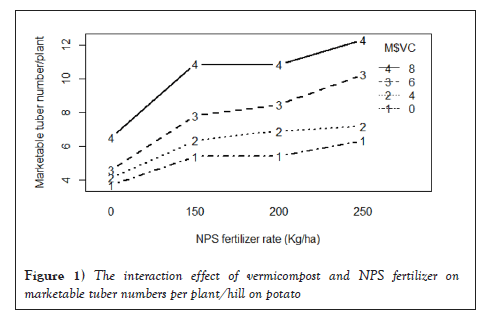
Figure 1: The interaction effect of vermicompost and NPS fertilizer on marketable tuber numbers per plant/hill on potato.
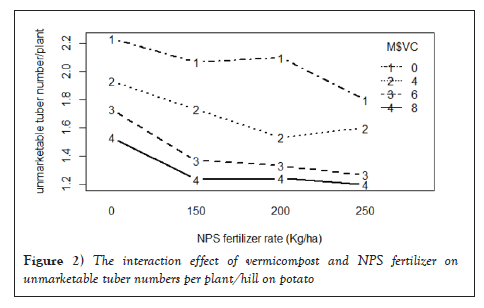
Figure 2: The interaction effect of vermicompost and NPS fertilizer on unmarketable tuber numbers per plant/hill on potato.
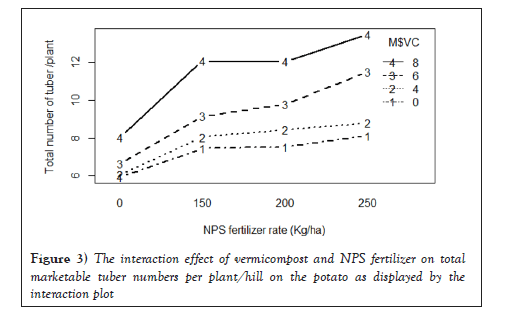
Figure 3: The interaction effect of vermicompost and NPS fertilizer on total marketable tuber numbers per plant/hill on the potato as displayed by the interaction plot.
Marketable tuber yield/ha (t ha-1)
Beside this, the result showed the application of 8 t ha-1 vermicomposts and 200 kg ha-1 NPS yielded (26.7 t ha-1) as compared to the unfertilized plot (8.2 t ha-1) (Figure 4) while an increasing vermicompost application from 0 to 8 t ha-1 resulted in reduction of unmarketable tube yield from 1.33 to 0.7 t ha-1 as compared to the control (Figure 5). Generally, the total tuber yield increased from 12.4 to 22.7 t ha-1 as the rate of vermicomposting increased from 0 to 8 t ha-1 which was a higher yield than that of yield of control (12.3 t ha-1) treatment. The lowest total tuber yield (12.7 t ha-1) was recorded from the control. Besides this, total tuber yield significantly increased with the application of 250 and 200 kg/ha NPS when combined with 8 t ha-1 of vermicompost, 27.9 and 27.3 t ha-1, respectively, and both are statically similar. The lowest total tuber yield (9.8 t ha-1) was obtained in control (12.0 t ha-1) (Figure 6).
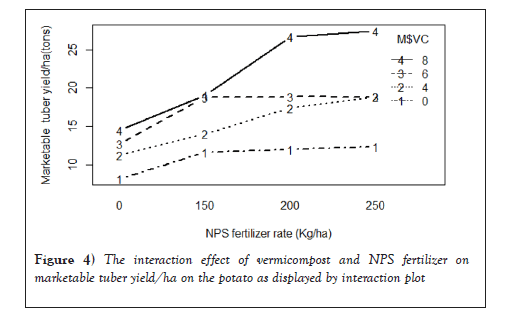
Figure 4: The interaction effect of vermicompost and NPS fertilizer on marketable tuber yield/ha on the potato as displayed by interaction plot.
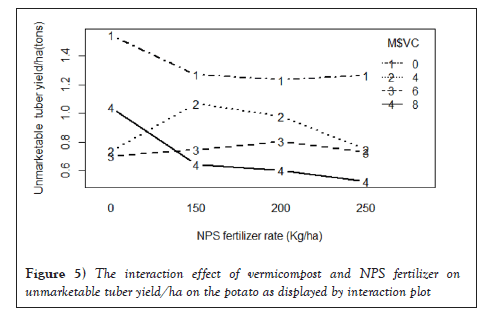
Figure 5: The interaction effect of vermicompost and NPS fertilizer on unmarketable tuber yield/ha on the potato as displayed by interaction plot.
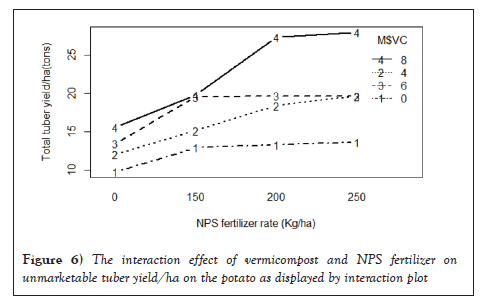
Figure 6: The interaction effect of vermicompost and NPS fertilizer on unmarketable tuber yield/ha on the potato as displayed by interaction plot.
Tuber dry weight and biomass yield/plant (g)
Application of 8 t ha-1 vermi-compost significantly increased tuber dry weight yield (138.5 g/hill) while the main effect of 250 kg/ha NPS was significantly higher in terms of tuber dry weight (121.4 g/hill). Moreover, treatment that received 8 t ha-1 vermi-compost along with 200 kg/ha NPS gave significantly higher tuber dry weight yield (173.49 g/hill) followed by 8 t ha-1 vermi-compost application with 250 kg/ha which was 167.6 t ha-1 (Figure 7). Besides this, above ground dry biomass significantly increased from the plot where 250 kg/ha NPS integrated with 8 t ha-1 of vermin-compost (56.4 g/hill) followed by application of 8 t ha-1 vermi-compost at 200 kg/ha NPS (42.6 g/hill) and the lowest aboveground dry biomass (20.5 g/hill) was found for control (Figure 8).
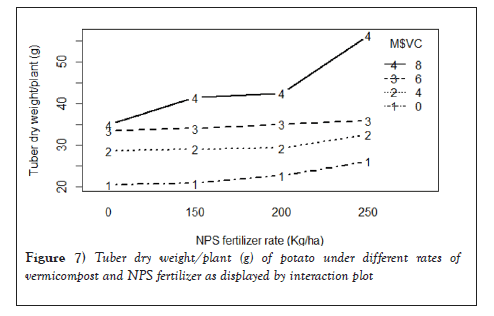
Figure 7: Tuber dry weight/plant (g) of potato under different rates of vermicompost and NPS fertilizer as displayed by interaction plot.
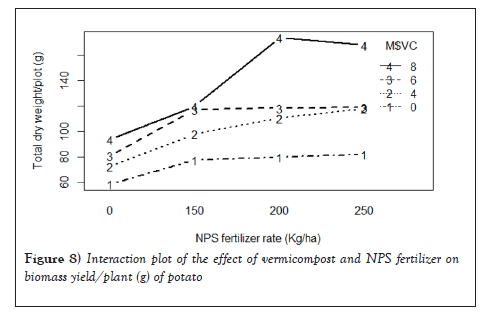
Figure 8: Interaction plot of the effect of vermicompost and NPS fertilizer on biomass yield/plant (g) of potato.
Weight of large tuber size/plant (g/hill) (>75 g): Application of 8 t ha-1 vermi-compost significantly increased large tuber size (280.8 g/hill) compared to 4 and 6 t ha-1. Similarly, the main effect of 250 kg/ha NPS was significantly higher in terms of large tuber size (220.1 g/hill). However, non-application of vermin-compost and NPS fertilizer showed the lowest large tuber size (96.9 and 110.6 g/hill) respectively. Application of 8 t ha-1 vermi-compost integrated with 200 kg/ha NPS had recorded maximum large tuber size (445.8 g/hill) followed by application of 8 t ha-1 vermi-compost integrated with 250 kg/ha NPS fertilizer. The lowest number of large tuber size (80.98 g/hill) was recorded from unfertilized plot (Figure 9).
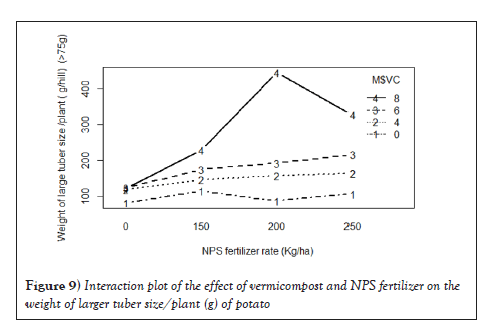
Figure 9: Interaction plot of the effect of vermicompost and NPS fertilizer on the weight of larger tuber size/plant (g) of potato.
Medium tuber size/plant (g/hill) (25-75 g): Application of 8 t ha-1 vermi-compost integrated with 250 kg/ha NPS had recorded maximum medium tuber size (314.67 g/hill) as compared to the lowest weight of medium tuber size (111.55 kg/hill) from unfertilized plot. An increasing vermin-compost and NPS fertilizers from control to 8 t ha-1 with 250 kg/ha increased the yield of medium sized tuber g/hill by 182.1% (Figure 10).
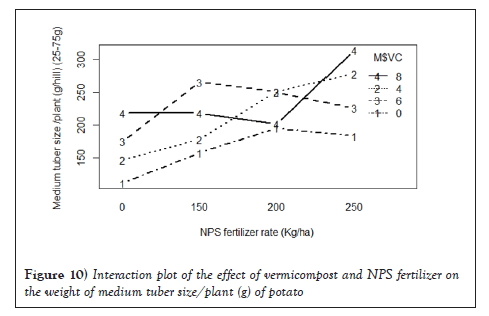
Figure 10: Interaction plot of the effect of vermicompost and NPS fertilizer on the weight of medium tuber size/plant (g) of potato.
Small tuber size/plant (g/hill) (<25 g): The interaction effect of vermin-compost and NPS fertilizers on small sized tuber was also highly significant showing varied response of one factor at other levels of the other factor. An increasing vermin-compost and NPS fertilizers interaction from zero NPS with zero vermin-compost to 8 t ha-1 with 250 kg/ha decreased the yield of small sized tuber by 36.5%. The lowest small tuber size (12.4 g/hill) was obtained from combination of 250 kg/ha NPS and 8 t/ha vermin-compost (Figure 11).
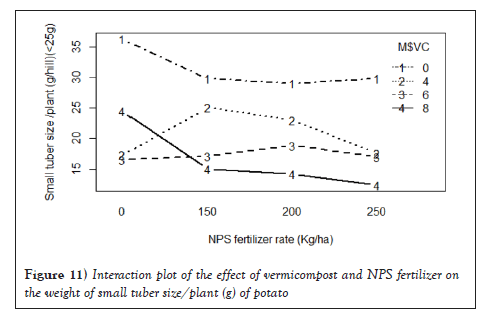
Figure 11: Interaction plot of the effect of vermicompost and NPS fertilizer on the weight of small tuber size/plant (g) of potato.
Partial budget analysis
The results of the study indicated that the application of blended NPS fertilizers integrating with vermin-compost had better benefits over the control and application of vermin-compost alone. Partial budget analysis was done according to CIMMYT (1988) recommendations, which stated that the application of fertilizer with the marginal rate of return above the minimum level (100%) is economical. Accordingly, the maximum net benefit of (2761.43 USD/ha-1) with an acceptable Marginal Rate of Returns (MRR%) of 315.90% was recorded in the treatment that received the application of 250 kg NPS fertilizer integrated with 8 t ha-1 vermi-compost rates. It was followed by the treatment that received the application of 200 kg NPS fertilizer integrated with 8 t ha-1 vermi-compost (2672.9 USD/ha-1) with the highest acceptable Marginal Rate of Returns (MRR%) (4137.27%).
However, the lowest net benefit of Ethiopian 880.7 and 947.5 ha-1 and non-acceptable Marginal Rates of Return (MRR%) were obtained from the plots received of 8 t ha-1 and 6 t ha-1 vermi-compost alone, respectively. The application of 200 kg blended NPS ha-1 with 8 ha-1 vermi-compost generated maximum marginal rates of return greater than the minimum considered acceptable to farmers (>1 or 100%). The identification of a recommendation is based on a change from one treatment to another if the marginal price of return of that trade is extra than the minimal fee of return. Based on this result, the application of 250 kg NPS fertilizer integrated with 8 t ha-1 vermi-compost rates and 200 kg NPS fertilizer integrated with 8 t ha-1 vermicompost was resulted within the maximum adjustable marketable tuber yield (24675.3 and 24005.7 kg ha-1), respectively, and profitable to the farmers in the study area (Table 3).
| Treatments | Unadjusted MTY (kg ha-1) | Adjusted MTY (kg ha-1) | Total Variable | Gross Return | Net Benefit (USD) | MRR (%) | B:C | |
|---|---|---|---|---|---|---|---|---|
| NPS kg ha-1 | VC kg ha-1 | Cost(USD) | (USD) | |||||
| 0 | 0 | 8210 | 7389 | 0 | 1285.7 | |||
| 150 | 0 | 11610 | 10449 | 84 | 1818.1 | 1734.1 | 533.54 | 20.63 |
| 200 | 0 | 12023 | 10820.7 | 112.1 | 1882.8 | 1770.7 | 130.87 | 15.8 |
| 250 | 0 | 12340 | 11106 | 140.1 | 1932.4 | 1792.4 | 77.20D | 12.79 |
| 0 | 4 | 11287 | 10158.3 | 696 | 1767.5 | 1071.5 | -129.66D | 1.54 |
| 150 | 4 | 14060 | 12654 | 780 | 2201.8 | 1421.8 | 416.71 | 1.82 |
| 200 | 4 | 17380 | 15642 | 808.1 | 2721.7 | 1913.7 | 1755.9 | 2.37 |
| 250 | 4 | 18867 | 16980.3 | 836.1 | 2954.6 | 2118.5 | 731.24 | 2.53 |
| 0 | 6 | 12717 | 11445.3 | 1044 | 1991.5 | 947.5 | -563.18D | 0.91 |
| 150 | 6 | 18797 | 16917.3 | 1128 | 2943.6 | 1815.6 | 1032.92 | 1.6 |
| 200 | 6 | 18873 | 16985.7 | 1156.1 | 2955.5 | 1799.5 | -57.52D | 1.56 |
| 250 | 6 | 18870 | 16983 | 1184.1 | 2955 | 1771 | -101.68D | 1.5 |
| 0 | 8 | 14513 | 13061.7 | 1392 | 2272.7 | 880.7 | -428.14D | 0.63 |
| 150 | 8 | 19093 | 17183.7 | 1476 | 2990 | 1513.9 | 753.42 | 1.03 |
| 200 | 8 | 26673 | 24005.7 | 43.6 | 4177 | 2672.9 | 4137.27 | 1.78 |
| 250 | 8 | 27417 | 24675.3 | 44.4 | 4293.5 | 2761.4 | 315.9 | 1.8 |
Note: Where, blended NPS cost=0.51 USD kg-1 of blended NPS, VC cost=0.15 USD kg-1, blended NPS application cost=0.06 USD kg-1 of blended NPS and vermicompost application cost=0.029 USD kg-1 of vermicompost (2 persons 100 kg ha-1, each 1.45 USD day-1 ), Application cost of blended NPS 5 persons 100 kg ha-1, each 1.16 USD day-1 , Field price of potato during harvesting=0.17 USD kg-1, MTY: Marketable Tuber Yield , USD=US dollar, MRR (%): Marginal Rate of Return and D: Dominated treatment, B:C: Benefit Cost ratio.
Table 3: Partial budget and marginal rate of return analysis for the response of potato to the application of vermicompost and blended NPS fertilizer rates at Gitilo (2019).
The significant (p<0.01) effect of main effects and interaction effects of both NPS fertilizer and Vermi-Compost (VC) on marketable tuber numbers per hill, number of total tubers, marketable tuber yield, unmarketable tuber yield, total tuber yield, tuber dry weight yield, above ground biomass, large-sized tuber, medium tuber size and small tuber size (Table 2) showed their magnificent influence on potato yield and yield component. This result coincides with Bekele [17] finding with regard to marketable tuber yield, total tuber yield and tuber dry matter content at combined blended NPSZnB fertilizer and cattle manure. An increase in levels of both factors tend to increase marketable tuber number per hill (Figure 1) which may be due to N influenced tuber formation in potatoes by influencing the activity and phytohormone balance in the plant, especially, on the levels of gibberellic and abscisic acid and cytokinins [18] and this growth in line with plant reaction to the accelerated utilization of combined NPS fertilizer and vermin-compost which might be due to the elevated performance of photosynthetic activity and translocation of photosynthetic to the root, which in all likelihood helped inside the initiation of greater stolon formation in potato and an earlier nitrogen application to potatoes earlier than tuber initiation will increase the wide variety of tubers in line with plant and sparkling tuber weight [19]. Gezahegn, et al. [20] report also showed the highest total tuber number hill-1 (16.00) was obtained from the application of 200 kg ha-1 NPSB fertilizer from Gudanie variety which was higher than this result (12.3). In such case an improved soil fertility and sustainable production with integration of inorganic fertilizer with vermicompost than inorganic alone.
Moreover, the high total and marketable tuber yields acquired due to the combined use of mineral and organic fertilizers may be attributed to the synergetic effect of mineral NP and cattle manure [21]. In another finding it was indicated that the number of tubers per hill was influenced significantly due to the application of different levels of vermicompost and NPKS. The maximum number of tubers per hill (8.33) was obtained from vermicompost (10.0 t ha-1) and NPKS (100%) [11] which was lower than in this study (12.3). Comparable result was obtained from 7.5 t ha-1 of vermicompost application with 75% inorganic NP resulted the maximum number of tubers of 14.21 and 10.90 per hill and marketable tuber numbers of 9.02 in Belg and 7.92 per hill in Meher season, respectively amounting to 30.84 and 13.57% increase [22].
Besides this, the result also revealed a significant marketable tube yield (26.7 t ha-1) increments compared to the control (8.2 t ha-1) (Figure 4) indicating about 98.58% marketable tube yield increments. Similarly, Alemayehu,et al. [23] and Yourtchi,et al.[24] reported that nitrogen fertilization significantly influenced marketable tuber yield. Zelalem,et al. [25] and Israel,et al. [26] also indicated N and P fertilization considerably motivates the productivity of potato measured in phrases of marketable and general tuber yields. Lowest recorded from unfertilized plots and growing rates of combined NPSZnB fertilizers. In another finding a combination of 75% inorganic NP and 7.5 t ha-1 vermicompost significantly increased total tuber yield, marketable tuber yield, and individual tuber weight, giving the maximum net benefits and marginal return rate [22]. Beside this, with the application of 200 kg ha-1 NPSB fertilizer application, the highest total and marketable tuber yields of 30.55 and 27.22 t ha-1, respectively were reported from Gudanie variety [20]. The highest marketable tuber yields received from blended use of mineral and natural fertilizers could be attributed be the synergetic effect of mineral NP and cattle Manure [21]. Tuber yield is basically synthesized due to the three physiological processes such as radiation interception, conversion of interception radiation to dry count number and the partitioning of dry depend among tuber and rest of plant of which NPS are the major components of physiological processes.
In addition to this, researchers also reported that the maximum marketable tuber yield (31.7 t ha-1) and total tuber yield (34.1 t ha-1) were recorded from combined use of 199 kg ha-1 of blended NPSZnB fertilizer and 30 t ha-1 of cattle manure; while the lowest values (9.8 t ha-1 and 12.29 t ha-1, respectively whereas caused significant reduction of tuber dry matter content [17] of which the maximum yield is higher than the highest value in this study though the 30 t ha-1 of cattle manure applied is very high. Moghadam, et al. [11] also indicated that tuber yield of potato was increased significantly due to the effect of vermin-compost (10 t ha-1) and NPKS fertilizers (100%) ranging from 8.58 to 25.56 t ha-1. While Alemayehu, et al. reported application of 245.1 kg ha-1 NPS combined with 13.5 t ha-1 farm yard manure caused the highest marketable and total tuber yields of 43.52 and 47.04 t ha-1, respectively, which is of the highest. Therefore, the application of vermin-compost along with NPS fertilizers increased organic matter contents, total nitrogen, available phosphorus, available sulfur, exchangeable potassium over the control. This in general improved organic matter and nutrient contents of the soils which in turn increased crop yields [12]. The finding obtained by Gezahegn, et al. [20] indicated the highest proportion of small size tubers were obtained from plots that received no fertilizer as compared to plots that received 200, 250 and 300 kg ha-1 NPSB fertilizer with the largest proportion of large size tubers. Sharma and Arora [27] investigated the effects of mineral nutrition on size categories of the potato tuber showing that an increase in the yield of tubers with applied nutrients was associated with an increase in the number of tubers in the medium (25-75 g) and large (>75 g) grades (length) at the expense of the small (<25 g) tubers. In another economistic profit analysis on potato indicted that the application of 245.1 kg ha-1 NPS combined with 13.5 t ha-1 FYM had the highest net benefit with acceptable marginal rate of return [23].
The analysis of variance showed significant effect of blended NPS fertilizer and vermin-compost as well as their interaction effects on all yield and yield component parameters studied indicating a high response of potato to change in both factors. The combined application of 250 kg ha-1 blended NPS fertilizer and 8 t ha-1 vermi-compost resulted in maximum value for most of the yield parameters including marketable tuber yield (27.4 t ha-1) and total tuber yield (27.9 t ha-1). Moreover, the application of 150 kg/ha combined with any one of the rates of vermin-compost was higher than the unfertilized plot and vermin-compost alone indicating that supplementing inorganic fertilizer with vermin-compost is the most important choice for sustainable potato production. The finding also showed the application of only vermin-compost showed a lower performance of potato than NPS fertilizer with vermin-compost suggesting that on a short time basis, regardless of its quantity, vermin-compost alone may not sufficient for optimum yield of the crop. The finding showed that the highest net benefit and marginal rate of return % were recorded from the integrated use of highest vermin-compost and NPS fertilizer a treatment receiving 8 t/ha vermin-compost along with 250 kg/ha are more profitable than the rest of treatment combination. Since at increasing levels of treatment resulted an increasing yield trend, further study is required to identify the optimum rate of recommendation of both fertilizers.
PC conceptualized and designed the experiment, analysed the data, and wrote the first draft manuscript. CM conducted the experiment, collected and analysed the data, and wrote the first draft manuscript. BMN designed the laboratory protocols and analyzed the soil’s physical properties. VM, IC, TM edited the first draft manuscript to the final manuscript. All authors read and approved the final manuscript.
The authors would like to thank Wollega University for their financial support to complete this study.
This research study was funded by Wollega University, Ethiopia.
All the data used in preparing this review paper are freely available as part of the article in FAIRsharing.org under figshare data repository (https://figshare.com/) with private link https://figshare.com/s/6eb93b3686f769583987 and DOI.10.6084/m9.figshare.19107881.
The authors declare that there was no conflict of interest.
[Crossref] [Google Scholar] [PubMed]
[Crossref] [Google Scholar] [PubMed]
[Google Scholar] [PubMed]
Citation: Wagari A, Jalata Z, Gobena A. Yield performance of potato (Solanum tuberosum L.) under integrated use of blended NPS fertilizer and vermicompost in Horo-Guduru area, Western Ethiopia. AGBIR.2023; 39(3):514-522.
Received: 15-Sep-2022, Manuscript No. AGBIR-22-74746; , Pre QC No. AGBIR-22-74746 (PQ); Editor assigned: 20-Sep-2022, Pre QC No. AGBIR-22-74746 (PQ); Reviewed: 07-Oct-2022, QC No. AGBIR-22-74746; Revised: 18-Oct-2022, Manuscript No. AGBIR-22-74746 (R); Published: 01-May-2023, DOI: 10.35248/0970-1907.22.39(3):514-522
Copyright: This open-access article is distributed under the terms of the Creative Commons Attribution Non-Commercial License (CC BY-NC) (http:// creativecommons.org/licenses/by-nc/4.0/), which permits reuse, distribution and reproduction of the article, provided that the original work is properly cited and the reuse is restricted to noncommercial purposes. For commercial reuse, contact reprints@pulsus.com This is an open access article distributed under the terms of the Creative Commons Attribution License, which permits unrestricted use, distribution, and reproduction in any medium, provided the original work is properly cited.
